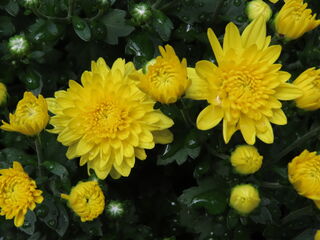Optimism
Unexpected Signs of Hope
Two potted plants had a surprise for me this spring.
Posted April 26, 2021 Reviewed by Ekua Hagan
Last August, I bought two potted chrysanthemum plants at my local gardening store.
I wanted to bring a modicum of cheer to the deck of my suburban townhouse as the coronavirus pandemic dragged on and so many other aspects of life in this country seemed desperately bleak, too.
One of the store’s gardeners helped me choose twin plants with plenty of yellow buds but few actual flowers. I placed the pots on small side tables at the corners of my deck, watered them periodically, and waited patiently to see if they would bloom.

My green-thumb talents are largely limited to indoor plants, but I am happy to report that my tentative venture into outdoor gardening succeeded splendidly. The dozens of buds on each plant opened gradually over the next four weeks; by late September, my deck was something of a fall wonderland.
As leaves from the trees behind my house drifted onto my deck, the bright yellow mums beautifully complemented the falling leaves’ golden hues. In the soft autumn sunlight, the many shades of yellow and gold made a pleasing contrast to the dark wood of the deck and the deep browns of the deck table and chairs.
For just under $33 (for the two potted plants and two handsome clay saucers), I had transformed my small deck into a haven from the harsh realities of the world.
As the weather turned colder, I did my best to prolong the life of the mums. I brought them inside my house during the first evening frosts, hoping I was not also importing a strange crew of insects I would be living with all winter long.
But each morning I returned the mums to their tables, willing the sun to warm them and revive what I feared might be their drooping plant spirits.
As the remaining flowers shriveled and died on their stems and the fall turned inevitably to winter, however, I stopped bringing the pots inside overnight.
I put away my deck furniture, set the mums in their pots on the part of the deck closest to the house, and prepared to feel both sadness and guilt as they gradually succumbed to the cold.
I consulted some online gardening sites for advice about preserving the mums over the winter. But the procedures seemed too complicated for an amateur gardener and the outcome too uncertain. Reluctantly, I resolved to let nature take its course.
Winter in my area seemed endless this year, with snow or sleet on 25 separate occasions between early December and early April, and many days of bitter cold and fierce winds.
I opened the sliding door to my deck infrequently; when I did, I saw that the potted mums had become two hemispheres of dry, brown stalks, with no signs of life.
Pitching them in the trash seemed both wasteful and cruel, so I resolved to take them to a nearby composting center in the spring.
A few weeks ago, when the multitude of robins and flowering trees in my neighborhood convinced me that winter was finally over, I stepped out on my deck for some spring cleaning.
After sweeping the floorboards and setting up the deck table and chairs, I turned my attention to the potted mums.
The best approach, I thought, would be to cut off the dry, brown stalks and then call the composting center to see if they would take the soil in the pots. Armed with gardening shears and gloves to protect my hands from the sharp, spiky stalks, I set to work.
I had cut away about a quarter of the stalks from the first plant when I suddenly stopped in disbelief. Peeking up from the soil at the base of the stalks was a splash of bright green that looked suspiciously like a leaf.
Incredulous, I resumed my trimming work, but this time with greater care. And sure enough, the more I cut, the more clearly I could see that several small, green leaves had emerged from the soil surrounding the dry stalks.
I repeated my trimming process on the second pot, with the same results. To my astonishment, it seemed that—with no help whatsoever from me—both plants had survived the winter and were joyfully signaling, with their green leaves, that they were far from ready for the compost heap.
I was so surprised that I consulted an online gardening site to verify that the leaves in the pots were indeed chrysanthemums and not those of some rogue interloper. And then I began to treat the mums like the small miracles of nature they seemed to be.
I restored them to their side tables, placing them where they would get the best sunlight each day. I watered them diligently. I brought them inside during the nights in April when we had frost.
In return, they have continued to grow and sprout more bright green leaves. And as symbols of plucky, against-all-odds resilience, they have greatly lifted my spirits—which have been battered by the pandemic, the harsh winter, and the inescapable evidence of the yawning divide between the world as it should be and the unjust, unforgiving reality so many people are forced to inhabit in 2021.
As my respect for these hardy plants increased, I did a little online research into the background of chrysanthemums. I learned they were first cultivated in ancient China, and different cultures have invested them with different meanings.
According to the florist website FTD, “Chrysanthemums generally symbolize longevity, fidelity, joy, and optimism.”
By so unexpectedly springing back to life, my mums have certainly brought me joy, as well as the promise of their own longevity.
With respect to fidelity, they may teach me to have more faith in the regenerative power of nature. And that faith just might lead me to optimism.
As painful as the present times are, perhaps we should not lose optimism and hope that—provided we work hard together to make it so—the future can be better for all of us.
Copyright © 2021 by Susan Hooper




